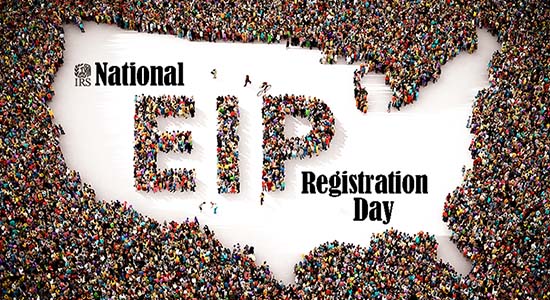Millions of low-income Americans still need to register to get an Economic Impact Payment
Get to know the IRS, its people and the issues that affect taxpayers
By Terry Lemons | November 5, 2020
As the holidays approach at this time of year, we often think a lot about gratitude. Reflecting on 2020, I’m grateful for the many ways the IRS workforce and the tax community partners have stepped up to help others in these challenging times.
One exceptional example: Watching IRS employees and our valued partners tirelessly work to spread the word about Economic Impact Payments. At $1,200 per person and $500 for each qualifying child, these payments can make a difference.
But our work is not done, and we really need your help in this final stretch. Millions of low-income Americans still need to register with the IRS by November 21 to get a payment this year.
The IRS set November 10 as "National EIP Registration Day." It’s a final push to encourage everyone who doesn't normally file a tax return to register to receive an Economic Impact Payment. We’re asking everyone to help reach someone who may still qualify in the coming weeks.
For our part, we’ve developed many resources you can use right up until the November 21 deadline.
From toolkits and tax tips to videos and fliers, the IRS developed more than 200 EIP materials in several languages. IRS.gov has about 100 FAQs to answer top EIP questions. Our social media activity includes hundreds of posts and social media images, with a special push to support the final registration drive in multiple languages launching soon. And our outreach staff across the IRS have been collaborating with partner groups nationwide. Like many other employees across the IRS, I’ve even pitched in myself to spread the word.
I’ve been at the IRS for more than 20 years, and this work has been unprecedented, topping anything the agency has done during previous stimulus efforts.
For example, our partner groups helped us translate materials such as the IRS EIP webpage and other helpful materials into 35 languages including Vietnamese, Korean, Russian, Spanish and Haitian Creole. This effort was phenomenal, providing valuable information to more people in more languages than ever before.
Who needs to act soon to get an Economic Impact Payment this year
Eligible people who don’t normally file a tax return need to sign up by 3 p.m. ET on November 21. They can use our Non-Filers: Enter Info Here tool, which is free, secure and available at IRS.gov.
The tool is designed for people with incomes typically below $24,400 for married couples, and $12,200 for singles. This includes people with no income and those who are experiencing homelessness. To be eligible, a person can’t be claimed as a dependent by someone else. People who receive Social Security, Supplemental Security Income, Railroad Retirement or veteran's benefits, but didn't receive a $500 per child payment with their own Economic Impact Payment, can also use the tool by November 21 to get the payment for their child.
This sweeping EIP effort and expanded partnerships are the IRS’s broadest public awareness campaign in more than a decade and helped more than eight million people use the Non-Filers tool so far.
How you can help
We’ve developed a lot of material, so I want to steer you towards simple ways you can help in these final weeks and the best resources to use. Whether you’re able to help people in person or offer curbside services or communicate virtually, we have materials you can use to spread the word.
Some people simply may not realize they are eligible for a payment or they don’t know how our Non-Filers tool can help. The materials on our Economic Impact Payments: Partner and Promotional Materials page include e-posters, a non-filers video, tax tips and short ready-to-use articles for your websites, emails, newsletters or bulletin boards. You’ll find:
- General materials to spread the word about the November 10 EIP Registration Day
- Special materials for people who are experiencing homelessness
- Tailored materials for people who receive federal benefits but didn’t get a $500 payment for their child earlier this year
- Social media images and content to post on your own platforms
You can also follow IRS on social media and share IRS posts about Registration Day or EIPs in general.
Some people may need to use an organization’s computer to get to IRS.gov and use the Non-Filers tool. If you can offer that, check out our customizable e-poster (in English and Spanish). You can add your organization’s contact information to promote your services on, before or after EIP Registration Day. We also have an instructional toolkit to guide you through all the steps of the Non-Filers tool.
Extensive 2020 outreach efforts
We are committed to getting everyone the money they deserve. We launched our Non-Filers tool in April, engaged our partners early, and we haven’t stopped trying to reach those who need to use the tool to get their payment. So far, this sweeping EIP effort and expanded partnerships helped more than eight million people use the Non-Filers tool. Here are some highlights:
- We’ve reached beyond our normal contacts to develop hundreds of new partnerships to reach many lower-income, military, veterans, retired, older, limited English proficiency and homeless communities, in multiple languages.
- We’ve been collaborating with more than 250 federal, state and local government agencies and Congressional offices to provide an extra way to reach more people directly, including those who don’t normally file a tax return.
- Our Stakeholder Liaison group regularly engages with more than 2,800 partners, including business organizations, local/state governments, tax practitioner organizations and community organizations to share EIP information.
- Our National Public Liaison group helps keep tax industry partners in the loop. These are top leaders for national tax professional organizations, tax and software industry organizations, and payroll and small business organizations.
- This fall, we used data from W-2s and 1099s to identify millions of people who might be eligible for a payment but don't normally file a tax return and sent them letters urging them to check their eligibility and register for a payment before the approaching deadline.
We’ll be doing more in the final days before the deadline, and I hope you will join us to make a difference. I’ve been proud to watch the IRS quickly deliver essential relief to families and businesses this year. Our workforce has done an amazing job adapting to operational challenges, telework transitions and new safety protocols as well as juggling personal challenges.
We know many Americans could use an Economic Impact Payment to help them through a hardship, so we appreciate everyone’s help to reach them. We also know community organizations continue to face their own unique challenges – and so we deeply value any efforts, large or small, to help people meet the November 21 deadline to use the Non-Filers tool.
Terry Lemons
Communications & Liaison Chief
Some additional points about using the Non-Filers tool at IRS.gov to register for an EIP:
- Anyone using the Non-Filers tool can speed up the arrival of their payment by choosing to receive it by direct deposit. Those not choosing this option will get a check.
- The payment is not taxable income and getting one does not affect eligibility for other benefits, such as the Supplemental Nutrition Assistance Program, unemployment benefits or other benefit programs.
- Beginning two weeks after they register, people can track the status of their payment using the Get My Payment tool, available only on IRS.gov.
- Anyone who misses the November 21 deadline can claim the payment as a credit by filing a 2020 federal income tax return, if they’re eligible. However, using the Non-Filers tool before November 21 is the quickest way for non-filers to get an EIP, so we encourage them to visit IRS.gov/nonfilerEIP as soon as possible.
About the author
Terry Lemons serves as the Chief of Communications & Liaison (C&L) at the IRS. In this role, Terry oversees the agency’s work involving public affairs, outreach to tax professionals and other partners, Congressional relations as well as social media and other external and employee communications.
Subscribe
The IRS offers several e-News subscriptions on a variety of tax topics. Subscribe to get email alerts when new content is posted.

 )
or https:// means you've safely connected to the .gov website. Share sensitive information only on official, secure websites.
)
or https:// means you've safely connected to the .gov website. Share sensitive information only on official, secure websites.



